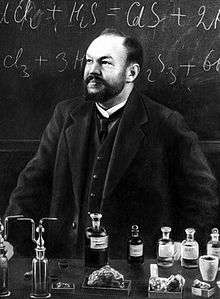Lev Chugaev
| Lev Aleksandrovich Chugaev | |
|---|---|
 | |
| Born |
16 October 1873 Moscow, Russian Empire |
| Died |
26 September 1922 (aged 48) Gryazovets, Russia (RSFSR) |
| Institutions |
University of Moscow, University of Saint Petersburg |
| Alma mater | University of Moscow |
| Known for | Chugaev reaction |
Lev Aleksandrovich Chugaev (16 October 1873 – 26 September 1922) was a Russian chemist. At the height of his career, he was professor of chemistry at the University of Petersburg, being the successor to Mendeleev. He was active in the fields of inorganic chemistry, especially platinum group complexes, as well as organic chemistry.[1][2][3] He is also known as Leo Aleksandrovich Tschugaeff or Tschugaev.
Contributions to coordination chemistry
Chugaev discovered that dimethylglyoxime forms a scarlet solid upon reaction with nickel(II) ions. This reaction was one of the first "spot tests" for a metal ion. An adherent to the theories of Alfred Werner, Chugaev made several contributions to the chemistry of platinum. The salt [Pt(NH3)5Cl]Cl3 containing the chloropentammineplatinum(IV) ion, is called "Chugaev's salt".[4] Other complexes prepared in his laboratory include [Pt(SEt2)4][PtCl4], [Pt(NH3)5OH]Cl3, [Os(SC(NH2)2)6]Cl3.H2O.
Chugaev also studied complexes of hydrazine. One of his complexes, since also called Chugaev's salt, was the product of the reaction of platinum(II) salts with methyl isocyanide and hydrazine.[5] After many decades, this compound was shown to be a carbene complex, probably the first metal carbene complex ever reported.[6]
Contributions to organic chemistry
He discovered the Chugaev reaction during his work on thujene an terpene.
References
| Wikimedia Commons has media related to Lev Chugaev. |
- ↑ Kauffman, G. B. (1963). "Terpenes to Platinum: The Chemical Career of Lev Aleksandrovich Chugaev". J. Chem. Educ. 40: 656–665. doi:10.1021/ed040p656.
- ↑ Kauffman, G. B. (1973). "A Russian Pioneer in Platinum Metals Research The Life and Work of Lev Aleksandrovich Chugaev" (PDF). Platinum Metals Rev. 17: 144–148.
- ↑ J. A. Voelcker; A. Harden; T. M. Lowry; Percival J. Fryer (1923). "Obituary notices: Frederick James Lloyd, 1852–1922; Georg Lunge, 1839–1923; Alexander Smith, 1865–1922; Jokichi Takamine, 1855–1922; Leo Alexandrovitsch Tschugaev, 1873–1922; Frank Edwin Weston, 1867–1923". J. Chem. Soc., Trans. 123: 946–959. doi:10.1039/CT9232300946.
- ↑ Yusenko, K.V.; Zadesenets, A.V.; Baidina, I.A.; Shubin, Yu.V.; Vasil'chenko, D.B.; Korenev, S. V. (2006). "Re-determination of the crystal structure and investigation of thermal decomposition of Chugaev's salt, (Pt(NH3)5Cl)Cl3·(H2O)". Zhurnal Strukturnoi Khimii. 47: 749–753. doi:10.1007/s10947-006-0362-0.
- ↑ Chugaev, L.; Skanavy Grigorieva, M.; Posniak, A. (1925). "Über Die Hydrazin-Carbylamin-Komplexe des Platins". Z. anorg. allgem. Chem. 148: 37–42. doi:10.1002/zaac.19251480105.
- ↑ Rouschias, G.; Shaw, B. L. (1970). "A revised structure for Chugaev's salt [PtC8H15N6]xClx". J. Chem. Soc. D: 183–183. doi:10.1039/C29700000183.